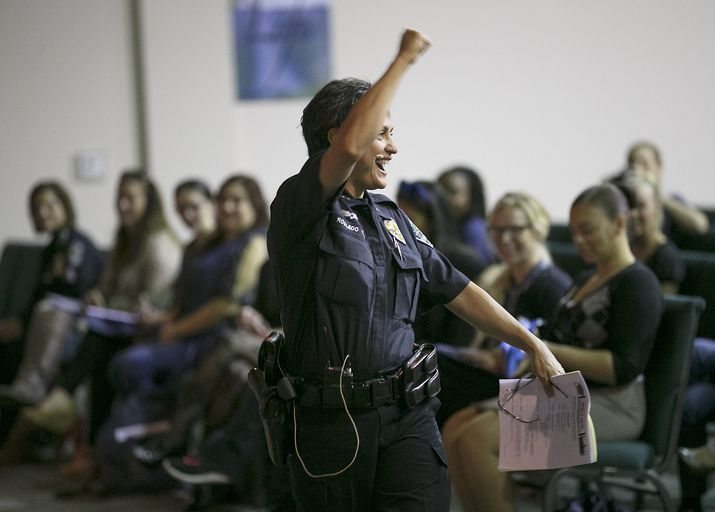By Lilly Rockwell
Austin American-Statesman.
Jessica Robledo stood before a group of three dozen women scattered throughout the pews of a cavernous East Austin church.
“Today is your day,” Robledo proclaimed to the group. “Today is about YOU! Be selfish.”
She paused, pacing up and down the center aisle. “Women have a tendency to put everybody ahead of them, and they leave themselves in the back,” She looked at a little boy sitting with his mother.
“Isn’t that right, Paulo? He knows that Mommy takes care of him, because that’s what we DO.” Another pause. “So how about you put YOU first? How about you say: ‘This is my goal.'”
Robledo is an assistant police chief in the Austin Police Department, the highest-ranking woman in a department that is 77 percent male.
Her mission at that Oct. 17 event was to persuade more women to join the Austin Police Department. It was the third recruitment meeting for women the department had held, and it also featured a YouTube video highlighting several women who work for the Police Department.
Such a gender disparity doesn’t only affect the Police Department. An American-Statesman analysis of the city government’s workforce — nearly 12,000 full-time employees as of April 1, the date of the data set provided in response to a records request — found nearly 70 percent of those city of Austin workers are men. Women become an even smaller percentage of the employees in higher-paying jobs.
That is largely due to a phenomenon known as “occupational segregation,” in which men seek careers, such as engineering, with more lucrative salaries, and women seek careers, such as library services, that don’t pay as well.
The Police Department is an example of how occupational segregation works. Of the 1,755 sworn police officers in the Statesman analysis, only 177 are women. But women make up a majority of the department’s “non-sworn” positions, jobs such as crisis counselors and 911 call-takers, which tend to be lower paid than on-the-streets police work.
Since women began working as police officers in large numbers in the 1970s, there has been little disagreement that women are capable of good police work, and yet it remains a male-dominated field.
Female police officers and gender pay experts told the Statesman there are several reasons for this. Some women are intimidated by the physical fitness test. Some struggle with the idea of balancing inflexible 10-hour shifts with their roles as primary caregivers to their children. And then there’s the psychological barrier of going to work every day as a minority surrounded by men.
The Austin Police Department is trying to address these concerns. For instance, at the recent recruiting session, Robledo said that no longer will women have to do push-ups to pass the fitness test. Women instead will perform a rowing exercise, news that was met with smiles and claps. (This goes into effect next year.)
Robledo also sprinkled her speech with plenty of acknowledgement that becoming a police officer is hard work — but that women are perfectly capable of doing it, just as she has. (She also talked about being discriminated against when she initially applied to be a police officer in a South Texas town.)
Still, it was a speech given later by Austin police Detective Joanna Candoli that highlighted the challenges the department faces in recruiting and retaining more women.
Candoli joined Austin’s police academy in the early 1990s. “There were instructors there who wanted to fire me,” Candoli said. “They didn’t think I was ready to be a police officer.” But other instructors saw potential.
“I didn’t know I wanted to be a police officer,” Candoli said. “I was dating a guy who wanted to be a police officer.”
Twenty-two years later, Candoli is still with the police. She started on patrol work, and she still gets teary remembering a key role she played early in her career tracking down a serial rapist terrorizing West Austin. She also worked several years on mounted patrol downtown (she got to keep her horse afterward), and she eventually ended up doing more investigative work, including a stint in the robbery division that was so busy and stressful that Candoli said she used to get spontaneous nosebleeds.
Once you have put in a few years in the department, she said, “they want you to succeed” and will help you find new career opportunities. “They will carry you so far,” Candoli said.
But she concluded with a confession: She has two young children and finds it challenging to juggle her “first calling” of police work with her “second calling” of being a mother.
“I’m eligible to retire in June, and I don’t know what I’m going to do,” Candoli said. “I really like what I do, but I have two kids.” Candoli said she was mulling over becoming a stay-at-home mom.
Though Candoli made it clear how rewarding she found police work, her candor struck a chord because she wasn’t just talking to a room full of women. She was talking to a room full of mothers.














































































































































































































































































































































































